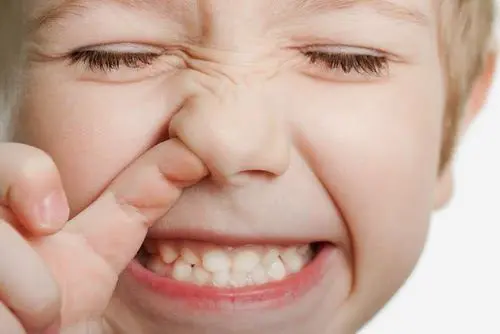One of my sisters has seven kids. There’s probably not anything her kids, nor any kids, could do that would surprise her at this point, but I remember back when she only had one kid. I remember when her first born was giggling away at his all-smiles uncle dancing about with corn on his teeth and in his nostril. I remember when said toddler rammed corn in his own nose in imitation, let out a giggle-snort and sucked that bad kernel right up his right nostril. I then remember said sister flipping out and having to call the ER for instruction on how to remove a piece of corn from a one and a half year old’s nose. I also recall the ER clerk laughing almost as hard as said toddler at the dancing-corn uncle.
While this story always gets a laugh at holiday gatherings where that toddler is now a teen, when your toddler has something in his or her nose, it’s not so comical. A toddler with a nose obstruction often sneezes a lot, or even gags, and it can be scary — not just because we all remember our own moms telling us if we put our finger too far up there we’d poke our brains, either. It’s because anytime anything is wrong with your child, it’s scary. So, what do you do if there’s something stuck in your toddler’s nose?
Assess the situation:
Before doing anything at all, stop and tell yourself to stay calm. If you’re calm, your toddler will be as calm as someone with something lodged in their nose can be, I suppose. In the majority of cases, while the object may annoy your child, it won’t hurt him or her. Find yourself a good light source, preferably something you can manipulate like a flashlight and have yourself a peak at what you’re dealing with. You want to answer two questions:
1. What’s stuck in your toddler’s nose? (On the off-chance you didn’t see what it was going in.)
2. How far up is what is in your toddler’s nose lodged?
Avoiding a laughing ER clerk:
If the object is close to the entrance of the nose or could be easily removed, simply get some tweezers, tip that tiny noggin’ back, brave the screaming, and remove said object. An infant nasal aspirator could possibly work depending on the item stuck as well. It may even help to simply have your toddler try to blow their nose. Often toddlers who don’t know how to blow their nose can still imitate the action if you do it first, so you may have to play monkey see, monkey do.
Some parents have luck with a bit unorthodox approach. First, lean your child back. Plug the nostril which isn’t currently containing something it shouldn’t, and then blow into your child’s mouth. Just one strong puff, and in many cases it flies right out, such as in the video below from Juggling the Jenkins:
When to call in professional reinforcement:
You could, of course, call a sibling with seven kids if you’re at-home-removal fails, but if you can’t get the object out, you will need to contact your doctor. In most cases, immediate removal isn’t necessary and the ER isn’t in your future.
Immediate care cases include:
-Batteries.
-Chemicals or items that contain chemicals, for example, a piece of a cigarette.
-A food stuff that may swell as a result of nasal moisture. Beans, in particular, seem to end up in
noses often.
-Something sharp.
-The lodged item is so far back in the nasal passage it’s affecting breathing, or has been inhaled into the throat or lungs and can’t be removed.
In all other cases, just getting into a clinic as soon as possible is fine. As an added note, if you remove an item and continue to see signs of a nasal blockage, you should see your doctor, as well.
Signs of a nasal blockage:
You thought I’d skip this part didn’t you? Truth be told, sometimes you may not even know your child put something in their nose. In these cases, watch out for:
-Frequent, unexplained or extended nose bleeds.
-Excessive nasal discharge or infection (not sure what an infection looks like? read about booger colors.)
-Sneezing, coughing, and other signs of an irritated nasal passage.
-Excessive picking of the nose.

